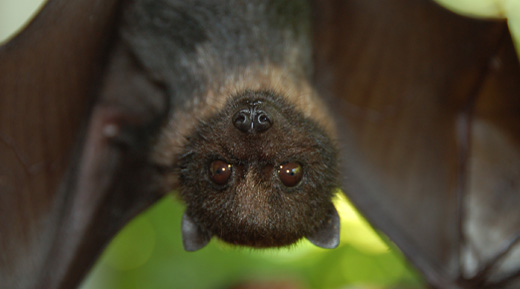
Hi everyone! I hope you all had a good week! Since the Japanese cherry blossoms are blooming in Washington, DC, I thought that I would write about a bat from Japan. I found an adorable fruit bat called the Mariana fruit bat. The Mariana fruit bat has dark brown to black fur covering most of its body with grey hairs throughout and a beautiful gold or pail brown neck floof. Mariana fruit bats live in tropical and subtropical climates of Japan, Guam and in the Marina islands. They like to roost in limestone forests, coconut groves, and vegetation. During the day they mostly sleep but they also groom, fly around, and climb around. They usually leave their roost to get dinner around sunset. Since these bats are fruit bats, they like to munch on fruit and occasionally flowers and leaves. Sadly, these bats are endangered. This is due to habitat loss caused by timber removal, natural disasters, and habitat destruction caused by non-native animals. They have also been hunted and killed as a crop pest. If you’d like to read more about these bats, you can read about them here.
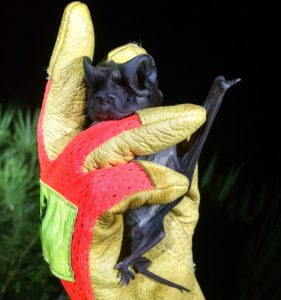
Hi everyone! Happy spring! I hope you all had a good week! I have some amazing news! There is a horticulturist in Florida who has created a bat house to help one of the world’s most endangered mammals. The house has been designed to help the Florida bonneted bat. This bat has sadly lost most of its habitat and only a few hundred are left. The new house is able to hold more bats that the ones most people have in their homes. Even though this house seems perfect for the Florida bonneted bat, there is a chance that it won’t attract bats to live there. While it’s sad to see an empty home, it will still help the bats. When they see a giant bat house, people passing by are drawn to it and become interested in what they can to do to help bats. The house was inspired by three houses used by a half-million bats at the University of Florida. It has two stories and a big roof for the bats to hide and rest in. Some bats such as the common Evening bat and the Brazilian Free-tailed bat like to roost in tightly packed spaces, so they might enjoy the lower level of the house that is a bit smaller than the top. The Bonneted bats are more solitary animals who will hopefully like the larger upper level of the house. If you would like to read more about this new house, you can read about it here.
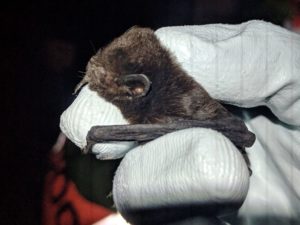
Hi everyone! I hope you all had a good week. I would like to dedicate this week’s blog to the people of New Zealand. My thoughts are with you all. I researched some bats from New Zealand and found a cute one called the Long-Tailed bat. They have beautiful long chestnut brown hair. Long-Tailed bats have small ears and very small bodies. They are about the size of a mouse and can fit in the palm of your hand. These bats eat insects like small moths, midges, mosquitoes, and beetles. They live in forests in old trees, under peeling bark, in large hollow stumps, and other holes that they can find. Sadly, these bats are categorized as Nationally Vulnerable. This is mainly because of people cutting down old trees that these bats live in. Predators such as cats, possums, and rats are also a threat. If you would like to read more about you can find information here. And please follow The Big Bat Year, a wonderful journey being undertaken by Nils Bouillard, who is trying to photodocument as many bat species as possible in 29 separate countries over the course of a single year. He has already visited New Zealand and has written about the experience and the bats he saw. He too is a wonderful blogger, so check it out! Happy St. Patrick’s Day! Don’t forget to wear green!
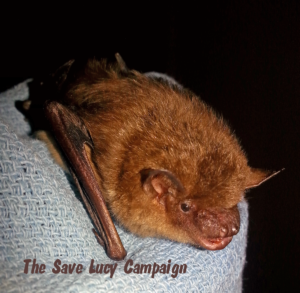
Hi everyone! I hope you all had a good week. Save Lucy’s President, Mrs. Sturges, found an interesting article that looks into the mystery of bat sounds. Scientists have found that some of the sounds that bats make resemble those of birds. Out of the 1,300 different bat species, the social vocalizations of about 50 have been studied. Of those 50, scientists discovered that about 20 of them are actually singing. It’s hard to hear bats singing if you go outside and watch them flying around. This is because a bat’s vocal range is in the ultrasonic range that is inaudible to human ears. In order to hear the bats’ sounds and research them further, scientists recorded bats singing and slowed them down. Their research has shown some similarities between bat and bird songs. Both bats and birds use the basal ganglia and prefrontal cortex parts of their brains to sing. Scientists believe that neural circuits also control bat vocals and how they are able to sing. Even though most bat species sing in an ultrasonic range, one species loves to sing in a range that humans can hear. The singing of the Greater Sac-Winged bat can be heard for miles. If you would like to read more about bats singing, you can find the article here. And now for a public service announcement. Daylight Savings Time begins on Sunday. Don’t forget to move your clocks 1 hour ahead before you go to bed tonight.
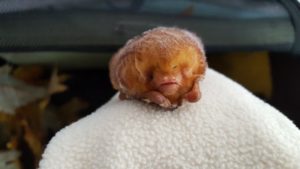
Hi everyone! I hope you all had a good week! I was home sick all week, so I didn’t really do much. I read an article about a new study being worked on by engineers at the University of British Columbia. The researchers are studying bat flight to help them develop better drones and other aerial vehicles. First the engineers built an aluminum bat wing and putting it in a wind tunnel. They then made a 3D computer model of the wing. They are studying how air flow affects the way a bat flies. Next, the engineers will make a physical model of a bat. This model will be used to study a bat in motion. Information learned will be used to optimize drone flight. They are hoping to make drones that will fly like automated bats with flapping wings. Groups of drones will be able to fly in a flock and will be used by businesses and emergency response. If you would like to read more, you can find the article here.
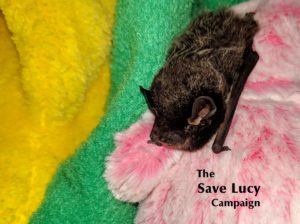
Hi everyone! I hope you all had a good week. I had a fabulous one because it was a holiday week and it snowed! Snow days are always especially fun! It’s been an exciting week at the Save Lucy Campaign. That’s because there is a cute new rescue. An adorable little Silver Haired bat was rescued a few days ago by the people working at the Hidden Oaks Nature Center in Annandale, VA. The bat is now being cared for by Save Lucy rehabilitators. The bat’s primary caretakers at Save Lucy have generously named him # 2019-19. Bats in rehabilitation are usually given numbers for names. However, seeing as no one wants their name to be a number, I think he needs a better name. Something sophisticated and grand. A name like Sherman! Since our newest addition is a Silver Haired bat, I thought I would write a little bit about them. They have beautiful black or, less commonly, dark brown fur. The hair on their back has lovely silver tips. These bats live throughout the United States and into Canada and Mexico. They haven’t been found anywhere above southeast Alaska though. One interesting fact about the Silver Haired bats is that they are one of the slowest flying bats in North America. If you would like to read more about silver haired bats in Alaska, you can do so here. I hope everyone has a fantastic week!

Hi everyone! I hope you all had a good week! I have been very busy with school and I’m looking forward to my three-day weekend. Recently, Franklin Junior High in St. Mary Parish in Louisiana has become a home to some fuzzy creatures. This is after Zachary High, the University of Louisiana at Monroe, and Gueydan High in Vermilion Parish became home to colonies of migrating Mexican free-tailed bats. A United Bat Control Owner went to Franklin Junior High to have a look. She says that it is most likely that the bats wanted to keep warm as they migrate north from Mexico to their spring homes. The bats decided to take up residency in the school’s gym. To protect the bats and the students, school was closed on the 14th and the 15th. School officials might have to close the school on Monday too, if they can’t get the bats out. Right now, their plan is to close all of the school’s doors and windows while the bats are all out hunting for tasty bugs. Then, before the bats come in again, they will seal up any openings to make sure the bats stay out in the wild where they belong. If you would like to read more, you can do so here.
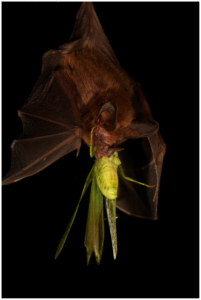
Hi everyone! I hope you all had a good week! I found a really interesting article about bats. The article is all about the importance of background noises. Some people think that background noise is a nuisance. Bats, however use the noises that they hear outside of their roosts to plan their outings. A group of researchers decided to test how background sounds affected a bat’s hunting habits. The scientists selected two bat colonies, one being the common big-eared bat (Micronycteris microtis) and the other the Pallas’s mastiff bat (Molossus molossus), and simulated the sounds of heavy downpours. When the bats heard the sounds, they stayed in their roosts! Bats don’t like flying in the rain because when their wings get wet, they have to use more energy to fly. Scientists don’t know exactly why else bats don’t like rain, but they believe it might jam their echolocation and their ability to navigate and find their dinner. The bats in the simulation didn’t like rain and decided to stay inside. For a comparison, the scientists also simulated the sound of normal forest sounds. The bats only stayed inside when the rain sounds were playing. The common big-eared bat also sent out a bat to investigate their environmental conditions. If you want to read more about this study, you can find it here.
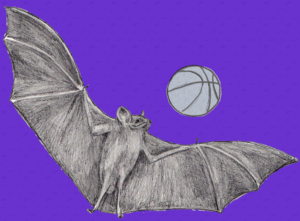
Hi everyone! I hope you all had a good week! I had a great one because I had almost no school! The polar vortex closed schools and caused delayed openings. We also got a little bit of snow. The teeny bit of snow caused them to close school on Friday. We have no school Monday because it’s a teacher work day. So, I have a 4-day weekend! And now for the bat news. At an NBA game between the San Antonio Spurs and the Brooklyn Nets, a few surprise guests appeared. A group of bats flew in from an unknown entry point and stopped the game. Security guards ran onto the court and started trying to catch them with a giant net! One member of the San Antonio Spurs, Manu Ginobili, has been known to catch these beautiful creatures. In a previous game of his, a Mexican free-tailed bat flew in and began flying around. Ginobili swatted the bat and gave it to an area attendant. If a creature, like a bat, does fly into your house or building, you should call someone trained to help in these situations. This could be Animal Control or a local wildlife facility. You should never take matters into your own hands unless absolutely necessary. Ginobili did not take the correct measures in safety, and had to get 16 rabies shots afterward. If you would like to watch the videos of the bats enjoying the basketball game, you can do so here. [Hitting a small flying animal in order to contain it is never appropriate. However, we are not sure why Mr. Ginobili had to have so many injections after his contact with the bat. Please be assured that normally, there are fewer injections. Don’t let fear of shots or needles keep you from seeking medical attention after a bite or scratch from […]
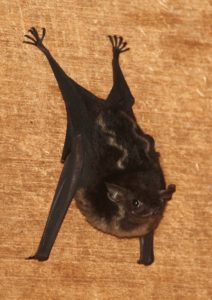
Hi everyone! I hope you all had a good week! Yesterday, a dam at an iron-ore mine in Brazil collapsed. Because of this disaster, I thought I would research a bat from Brazil. I found a very cute bat! It looks like a shrew that knows something you don’t. It’s called the Greater sac-winged bat. In addition to Brazil, these bats live in several other Central and South American countries. Their range is from central Mexico, through Central America, into South America. They live in the South American countries of Brazil, Bolivia, Guyana, Suriname, Guyane, and the Antillean islands. The Greater sac-winged bat has dark brown fur, and some have zig-zag stripes on their back. They have long noses and upper lips that are very mobile. They get their name from the small sacs or pouches on their wings. While grooming themselves, the males fill their sacs with drops of urine and glandular secretions. When they are trying to attract a female, the male will hover over her and flap the scent in their sacs toward her. They will also use this technique to ward off other bats from outside their territory. Another interesting fact about these bats is that their pups babble. They will vocalize calls and other sounds, but jumbled up just like a human baby’s babbles. This is the first mammal that is not a primate to be seen babbling. If you’d like to read more about the Greater sac-winged bat, you can find information here.









